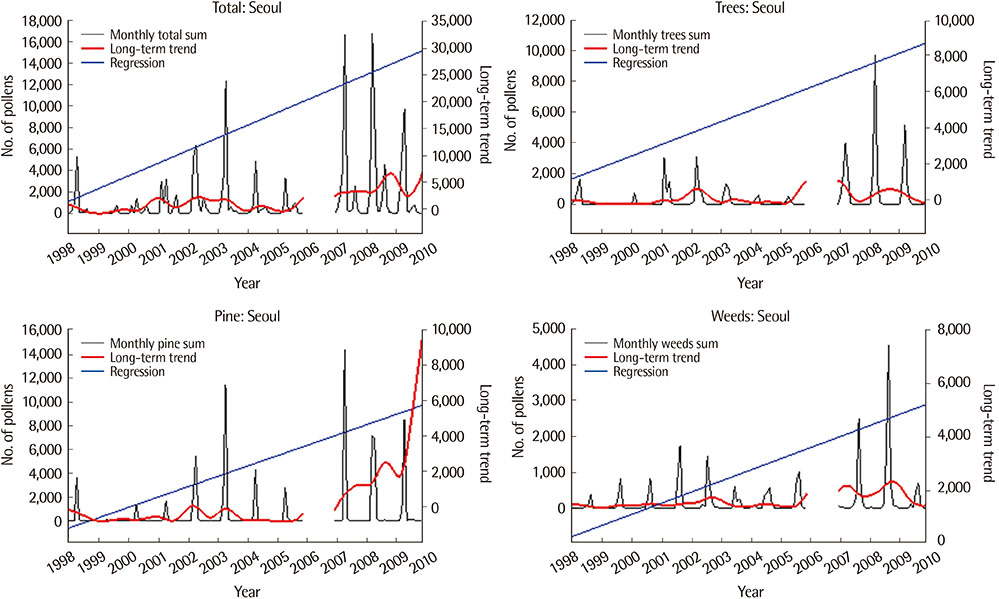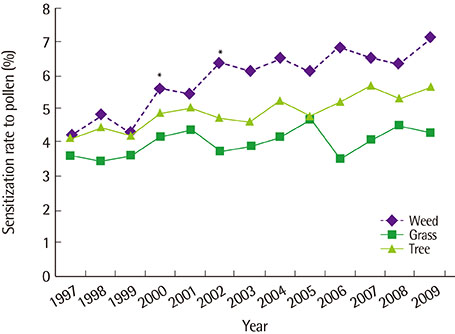Allergy Asthma Respir Dis.
2018 Sep;6(Suppl 1):S31-S39. 10.4168/aard.2018.6.S1.S31.
The impact of climate change on pollen allergy in Korea
- Affiliations
-
- 1Department of Pediatrics, Hanyang University College of Medicine, Seoul, Korea. jaewonoh@hanyang.ac.kr
- KMID: 2421505
- DOI: http://doi.org/10.4168/aard.2018.6.S1.S31
Abstract
- Weather may alter the concentrations of pollens which can subsequently influence the occurrence of allergic diseases. Many studies have demonstrated that greenhouse gases increase pollen concentration. Daily fluctuations in the pollen concentration have to do with a variety of meteorological factors such as temperature, rainfall and sunshine amount; therefore, it is complicated. At least more than 10 weather elements that affect the concentration of pollen. Earlier pollination and rising pollen concentrations have been reported in many countries. Most studies have focused on analysis of their relationships with local meteorological and climatic factors. Observed pollen data at locations representing a wide range of geographic and climatic conditions should be analyzed statistically to identify pollination date, pollen season length, and annual mean and peak values of daily concentrations of pollen. The seasonal and regional variations of pollen have also been changed in South Korea with climate change. There were evaluated sensitization rate to pollen in South Korea since 1997. Sensitization rates for weed and tree pollens are increased in Korean children, especially with increasing pollen concentration of ragweed and Japanese hop. It has been demonstrated that urbanization correlate with the increasing pollen allergies. However, the effects of environmental change on allergic diseases have not yet been completely understood. Recently there have been many epidemiological studies on the relationship between allergic diseases and climate changes. Previous studies suggest that climate changes interact with and affect pollen allergy, which in turn increases the frequency and severity of allergic disease.
Keyword
MeSH Terms
Figure
Cited by 1 articles
-
The publication of the 30th anniversary journal of Korean Academy of Pediatric Allergy and Respiratory Disease
Yeong-Ho Rha
Allergy Asthma Respir Dis. 2018;6(Suppl 1):S1-S2. doi: 10.4168/aard.2018.6.S1.S1.
Reference
-
1. Asher MI, Montefort S, Björkstén B, Lai CK, Strachan DP, Weiland SK, et al. Worldwide time trends in the prevalence of symptoms of asthma, allergic rhinoconjunctivitis, and eczema in childhood: ISAAC phases one and three repeat multicountry cross-sectional surveys. Lancet. 2006; 368:733–743.
Article2. Hwang SH, Jung SY, Lim DH, Son BK, Kim JH, Yang JM, et al. Epidemiology of allergic rhinitis in Korean children. Allergy Asthma Respir Dis. 2013; 1:321–332.
Article3. Beggs PJ. Impacts of climate change on aeroallergens: past and future. Clin Exp Allergy. 2004; 34:1507–1513.
Article4. Smith M, Emberlin J. A 30-day-ahead forecast model for grass pollen in north London, United Kingdom. Int J Biometeorol. 2006; 50:233–242.
Article5. Vázquez LM, Galán C, Domínguez-Vilches E. Influence of meteorological parameters on Olea pollen concentrations in Córdoba (south-western Spain). Int J Biometeorol. 2003; 48:83–90.
Article6. D'Amato G, Cecchi L. Effects of climate change on environmental factors in respiratory allergic diseases. Clin Exp Allergy. 2008; 38:1264–1274.7. Betts RA, Boucher O, Collins M, Cox PM, Falloon PD, Gedney N, et al. Projected increase in continental runoff due to plant responses to increasing carbon dioxide. Nature. 2007; 448:1037–1041.
Article8. Ziska LH, Gebhard DE, Frenz DA, Faulkner S, Singer BD, Straka JG. Cities as harbingers of climate change: common ragweed, urbanization, and public health. J Allergy Clin Immunol. 2003; 111:290–295.
Article9. Ziska LH, Epstein PR, Schlesinger WH. Rising CO(2), climate change, and public health: exploring the links to plant biology. Environ Health Perspect. 2009; 117:155–158.
Article10. Buck P, Levetin E. Airborne pollen and mold spores in a subalpine environment. Ann Allergy. 1985; 55:794–801.11. Oh JW, Lee HR, Kim JS, Lee KI, Kang YJ, Kim SW, et al. Aerobiological study of pollen and mold in the 10 states of Korea. Pediatr Allergy Respir Dis. 2000; 10:22–33.12. Oh JW, Kang IJ, Kim SW, Kook MH, Kim BS, Shin KS, et al. The correlation between increased sensitization rate to weeds in children and the annual increase in weed pollen in Korea. Pediatr Allergy Respir Dis. 2006; 16:114–121.13. Singer BD, Ziska LH, Frenz DA, Gebhard DE, Straka JG. Increasing Amb a 1 content in common ragweed (Ambrosia artemisiifolia) pollen as a function of rising atmospheric CO2 concentration. Funct Plant Biol. 2005; 32:667–670.
Article14. Basset IJ, Crompton CW. The biology of canadian weeds. 11 Ambrosia aremisiifolia L, and A. psilostachya DC. Can J Plant Sci. 1975; 55:463–476.15. Solomon WR. Ragweed pollinosis: answers awaiting explanations. Ann Allergy Asthma Immunol. 2001; 86:141–142.
Article16. Wayne P, Foster S, Connolly J, Bazzaz F, Epstein P. Production of allergenic pollen by ragweed (Ambrosia artemisiifolia L.) is increased in CO2-enriched atmospheres. Ann Allergy Asthma Immunol. 2002; 88:279–282.
Article17. Houghton JT, Meira LG, Callander BA. Climate change 1995: The science of climate change. Cambridge: Cambridge University Press;1996.18. Kang HN, Yun HS, Choi YJ, Oh JW, Min UY, Heo YS, et al. Evaluation of the association between pollen count and the outbreak of allergic disease. Allergy Asthma Respir Dis. 2016; 4:415–422.
Article19. Kim JH, Oh JW, Lee HB, Kim SW, Chung HL, Kook MH, et al. Evaluation of the association of vegetation of allergenic plants and pollinosis with meteorological changes. Allergy Asthma Respir Dis. 2014; 2:48–58.
Article20. Kim JH, Oh JW, Lee HB, Kim SW, Kang IJ, Kook MH, et al. Changes in sensitization rate to weed allergens in children with increased weeds pollen counts in Seoul metropolitan area. J Korean Med Sci. 2012; 27:350–355.
Article21. Oh JW. Characteristics and distribution of airborne pollen and mold. Pediatr Allergy Respir Dis. 1998; 8:1–15.22. Oh JW. Development of pollen concentration prediction models. J Korean Med Assoc. 2009; 52:579–591.
Article23. Kim KR, Kim M, Choe HS, Han MJ, Lee HR, Oh JW, et al. A biology-driven receptor model for daily pollen allergy risk in Korea based on Weibull probability density function. Int J Biometeorol. 2017; 61:259–272.
Article
- Full Text Links
- Actions
-
Cited
- CITED
-
- Close
- Share
- Similar articles
-
- Climate Change and Allergic Disease
- Impacts of climate change on aeroallergens
- The impact of climate change on aeroalleregen and pediatric allergic diseases
- Air pollution and climate change: Effects on asthmatic patients
- Climate change, air pollution, and biodiversity in Asia Pacific: impact on allergic diseases




